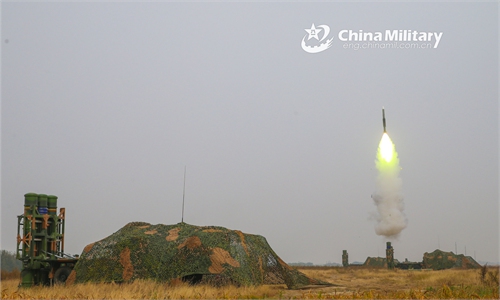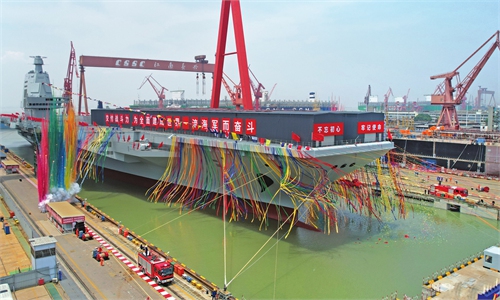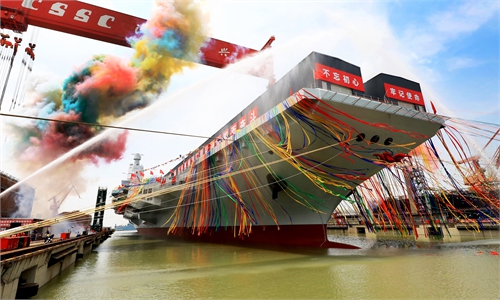IN-DEPTH / IN-DEPTH
Voyages to starry ocean: 10 years on, PLA Navy remains a staunch force in safeguarding natl sovereignty, world peace
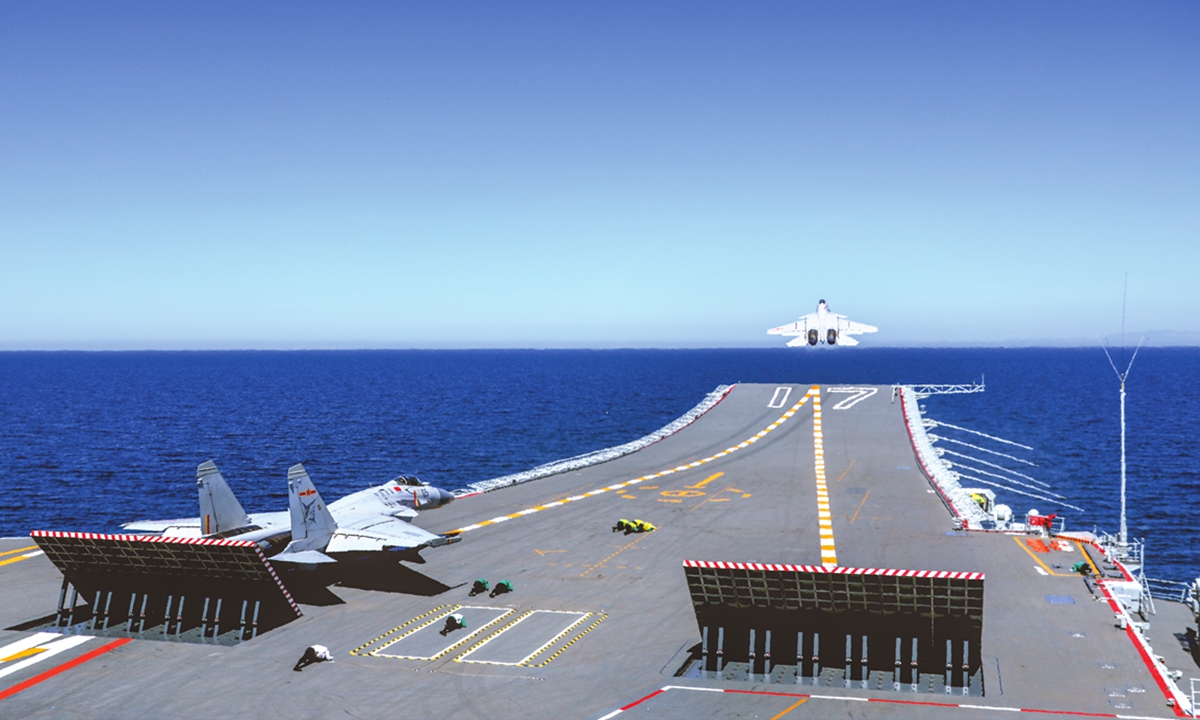
J-15 fighter jets commence takeoffs from the aircraft carrier Shandong. Photo: Courtesy of Ding Zheng
Editor's Note:Since the 18th National Congress of the Communist Party of China (CPC), the Chinese People's Liberation Army (PLA) Navy has witnessed fresh opportunity for its development and made a series of new achievements, and is striving toward the goal of becoming a modernized navy. As a military arm with international characteristics, the PLA Navy's trail covers six continents and four oceans, representing the image of China and attracting attention from the international community, particularly the aircraft carriers Liaoning and Shandong, and the 10,000 ton-class large destroyer Nanchang. In the past 10 years, new types of vessels entered service and enhanced combat capabilities, becoming the most direct witnesses of the PLA Navy's rapid development over the past decade. Shortly prior to April 23, the 73rd anniversary of the founding of the PLA Navy, commanding officers, a sailor, and a marine who sail together aboard warships shared their experiences over the past 10 years with the Global Times, depicting close-up portraits of the might of the PLA Navy in safeguarding China's sovereignty, territorial integrity, and national dignity, as well as world peace.
Executive officer of aircraft carrier Shandong
November 23, 2012 is the historic day when Dai Mingmeng became the first pilot to successfully execute an arrested landing on and ski-jump takeoff from an aircraft carrier with a J-15 carrier-borne fighter jet, opening a new chapter in China's aircraft carrier program. In late 2019, China's first domestically developed aircraft carrier, the Shandong, was commissioned into the PLA Navy, as China entered an era of operating two aircraft carriers.
Xu Ying, executive officer of the Shandong, who also possesses aviation qualifications, said that the PLA Navy will surely have more pilots, aircraft carriers, and carrier-borne aircrafts, as well as stronger capabilities and more reliable measures to firmly safeguard national sovereignty, security, and development interests.
To challenge the most difficult flight subjects, Xu made a transition from a normal fighter jet pilot to an aircraft carrier-borne fighter jet pilot in 2012.
Marking a new phase in the development of aircraft carrier combat capabilities, the PLA Navy established its first carrier-borne aviation force in 2013. As China's first-generation carrier-borne pilot team, Xu and his colleagues ventured into unfamiliar territory with no reserve of technique or zero experience - it would all have to be done on a trial-and-error basis.
In the past decade, Xu has witnessed China's aircraft carrier undertaking grow from scratch: From none to the first carrier, a single to two carriers, from daytime to nighttime operations, and from coastal to far sea operations. Now China has launched its third aircraft carrier in June.
Xu became the executive officer of the Shandong in 2021, which made him more emotionally attached to the aircraft carrier and carrier-borne aircrafts.
"As a pilot, I used to focus on aviation and support conditions. Now, as executive officer, I need to not only be concerned about aviation, organization, support, and the livelihoods of the crew, but also the condition of equipment as well as the tactical performance and application of weapons," Xu said. "This made me integrate more with the carrier," he said.
Having flown on two aircraft carriers gave Xu great confidence and pride. "As a pilot, I hope I can closely follow the marching stride of the PLA Navy, get a pilot's license for more aircraft carriers, conduct more sorties, and accumulate more experiences. They are reflections of a pilot's value and capability," Xu said.
Top non-commissioned officer on aircraft carrier Liaoning
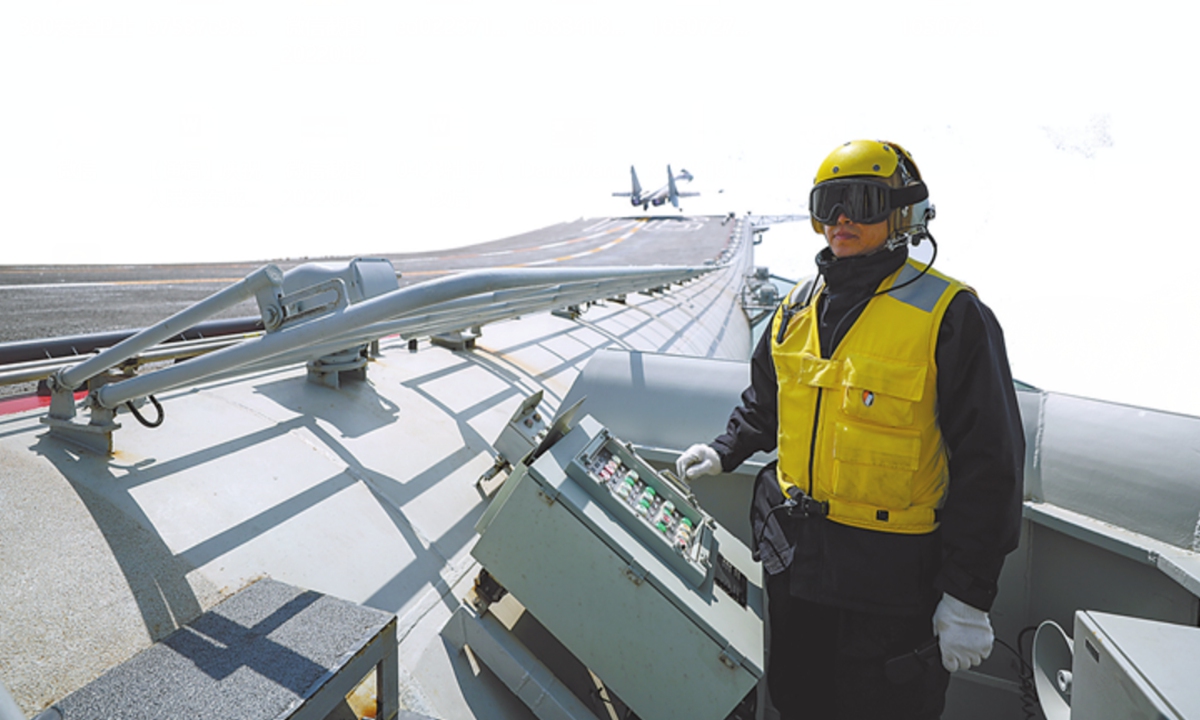
Zhang Naigang sets fly of J-15 fighter jets on the aircraft carrier Liaoning. Photo: Courtesy of Zhao Ziqing
Command master chief petty officer Zhang Naigang is the head of an aviation support branch on the aircraft carrier Liaoning who wears a yellow jacket, a communications helmet, and a pair of wind goggles, and works at the takeoff station by the side of the carrier's flight deck. "As an operator at the takeoff station, my job is to press the launch button and let fly J-15 carrier-borne fighter jet," he said.On September 25, 2012, the Liaoning entered service with the PLA Navy as China's first aircraft carrier. On November 23 of that year, Zhang pressed the launch button and the J-15 executed its first takeoff from the carrier for the first time. "I was so thrilled. It was an unparalleled excitement."
This excitement was like that of babies who just took their first steps in their lives, followed by even more life-changing moments as the babies grow up. In the past 10 years, the Liaoning has hosted nighttime takeoffs and landings, has had J-15s carry out buddy refueling activities, and has conducted realistic combat drills in far sea. "What seemed beyond reach before has now become ordinary and routine. As we launch more sorties and accumulate more data, our experiences become richer and we have no fear in facing more challenging missions, as we are confident that we can finish them," Zhang said, calmly but firmly.
Zhang, who joined the PLA in December 1994 and served for 28 years, said the past decade has been the fastest 10 years for the PLA Navy. Thanks to his service on the Liaoning, Zhang participated in maritime military parades in April 2018 and April 2019 and made a port call in the Hong Kong Special Administrative Region in 2017, which are opportunities that he said were hard to come by and made him feel honored.
During missions, Zhang often has a chance to see the Type 055 large destroyer and the Type 075 amphibious assault ship, which make him marvel at the PLA Navy's tremendous rapid development. He also has a close affection for the Shandong, the country's second aircraft carrier and the first domestically developed one, as many of the Shandong's crew members were first trained on the Liaoning.
"I image if we have another maritime military parade in the next decade, we will have more large vessels, more varieties of aircrafts, and more new equipment. The development of the Navy is so rapid that we will see a lot of breakthroughs that could be beyond imagination," Zhang said.
Skipper of the first Type 055 large destroyer, the Nanchang
Since the 18th National Congress of the CPC, the PLA Navy has seen several breakthroughs in development in the decade. One of them is the commissioning of the Nanchang, the first Type 055 10,000 ton-class destroyer, which is China's most advanced surface combatant in design concept. It marks the PLA Navy's leap from using third-generation destroyers to fourth-generation ones.
Senior Captain Zhou Minghui, the skipper of the Nanchang, has experience sailing with several different types of warships. He said that the PLA Navy's concept in using ships has changed drastically over the past 10 years thanks to its rapid development, as new-type vessels are bound to face more far sea challenges and contribute to the boosting of combat capabilities for even newer ships.
The Nanchang entered service with the PLA Navy on January 12, 2020. Before that, Zhou used to be the executive officer of the Type 052 destroyer Qingdao in 2012, and later skipper of the Type 052D destroyer Xining. This means Zhou worked on three generations of Chinese main battle vessels.
As a vessel commanding officer who has served his country for 25 years, Zhang said he felt a change in detail in recent two years. "We are now very open. When we encounter foreign warships, we actively communicate and interact with them using the Code for Unplanned Encounters at Sea or the International Regulations for Preventing Collisions at Sea, so we can notify them about our situation as soon as possible. In the past, they were the ones who would actively communicate. But now it feels like the roles have been switched, and they have become prudent," Zhang said.
For example, when the Nanchang once sailed near the Sea of Japan, Japan sent forces to monitor. "Our sailors acted confidently and calmly. Whether through radio communication with foreign vessels or in terms of taking advantageous positions when maneuvering, we were not inferior to any other ship. This further demonstrates our ship's outstanding performance," Zhang said.
"When we were sailing in far sea in 2021, we made contact with a Chinese commercial vessel and also happened to be there through radio communication. When we identified ourselves as PLA Navy warships, we could feel their excitement and happiness even through the microphone. Every time we communicate with Chinese commercial or fishing ships at sea, we feel their confidence in us. This makes us very proud," he said.
Marine elite who sails with ships and fights on land
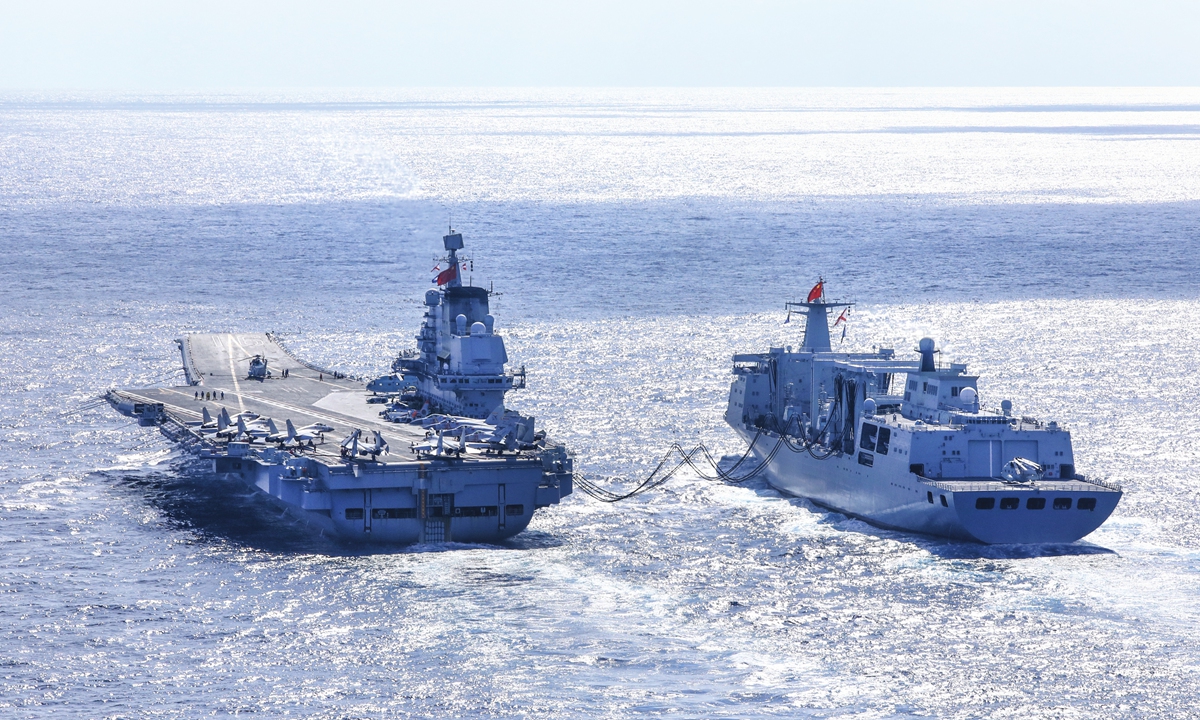
Aircraft carrier Liaoning receives maritime replenishment at sea. Photo: Courtesy of Hu Shanmin
In the eyes of Xu Xiaofei, a member of the PLA Marine Corps, his unit is far more powerful than the Jiaolong Assault Team depicted in the movie Operation Red Sea in terms of both personnel and weaponry.As one of the five branches in the PLA Navy, the Marine Corps can often be seen in far sea escort taskforces and joint drills. Since 2012, Xu has sailed with warships and has taken part in escort missions in the Gulf of Aden, carried out mission duties in the PLA Support Base in Djibouti, and participated in China-Russia maritime joint drills.
"Joining the military is the best stage and the correct decision in my life." Xu frankly said that before signing up for the military, he had nothing to do but play online games all day without any ambitions or dreams. When he graduated from college at 21, Xu decided to follow the popular saying of "Joining the military will make you regret for two years, but not joining will make you regret for your entire life," so he joined the most challenging Marine Corps.
Even today, Xu still remembers the hardship during the initial stage of training. "We learned some 50 to 60 courses including gun wielding, shooting, diving, parachuting, and demolishing. Every day we were either training or on our way to training. We could never sleep well, because there could be an emergency assembly whistle at any time, or an instructor could throw a gas grenade into our dorm." But Xu enjoyed challenges like these, as now he can operate more than 20 types of weapons. He likes driving vehicles the most, and excels at sniping.
With the reform of the Marine Corps in 2017, Xu and his colleagues can carry out special-mission tasks including amphibious landing and multi-domain combat missions anytime, anywhere.
Speaking about changes over the past decade, Xu said that he felt the growing strength of the country, which is closely connected to his pride as a member of the PLA. "I participated in the evacuation mission of Chinese nationals in Yemen. When they boarded our ship, I felt the strength of the motherland when I saw them hugging the national flag and kissing the warship." "I once flew with the Y-20 transport aircraft for an overseas mission, and when we arrived, I saw admiration in the eyes of foreign troops. I, again, deeply realized the power of the motherland."
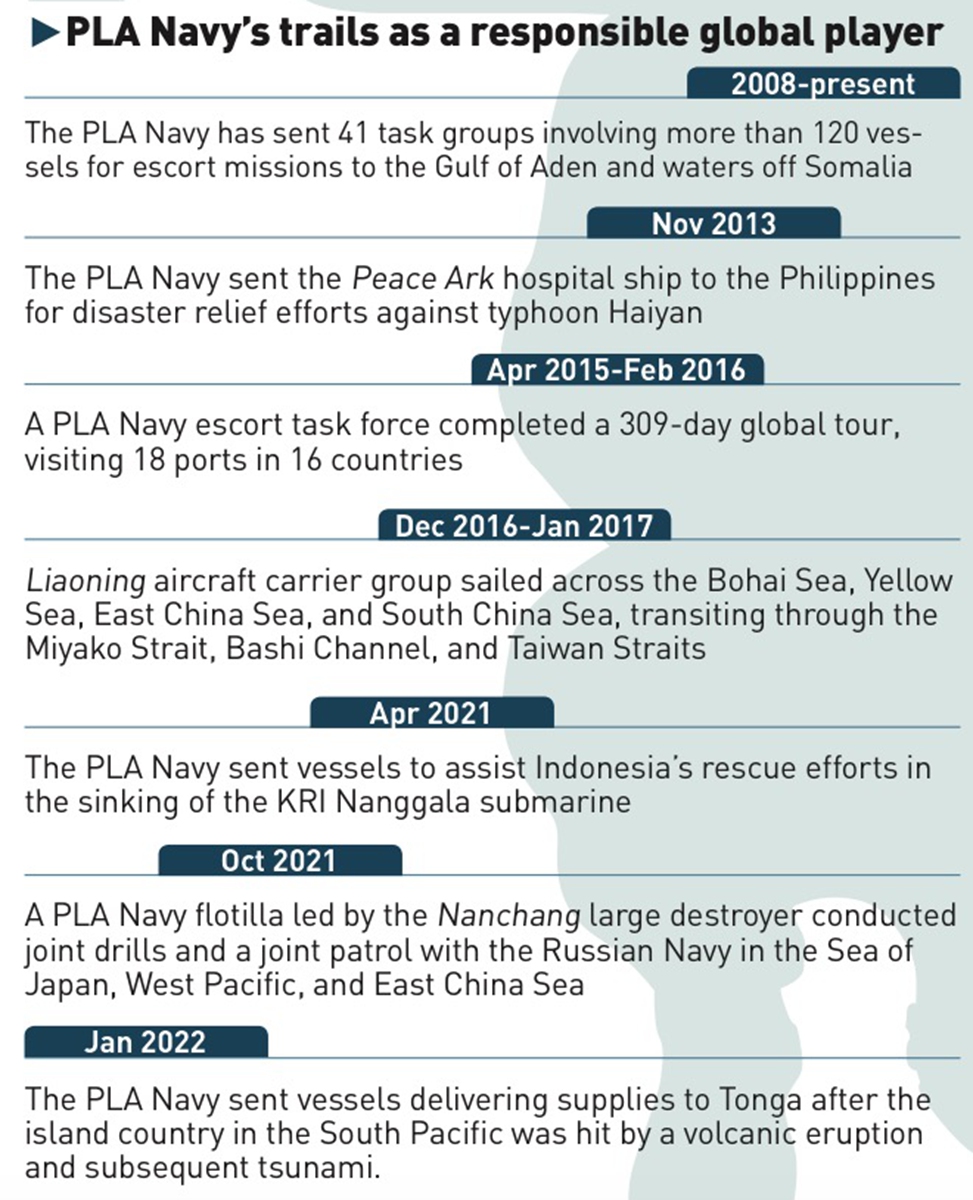
Graphic: GT

